gearbox CITROEN DS3 CABRIO 2014 Handbook (in English)
[x] Cancel search | Manufacturer: CITROEN, Model Year: 2014, Model line: DS3 CABRIO, Model: CITROEN DS3 CABRIO 2014Pages: 384, PDF Size: 11.85 MB
Page 179 of 384
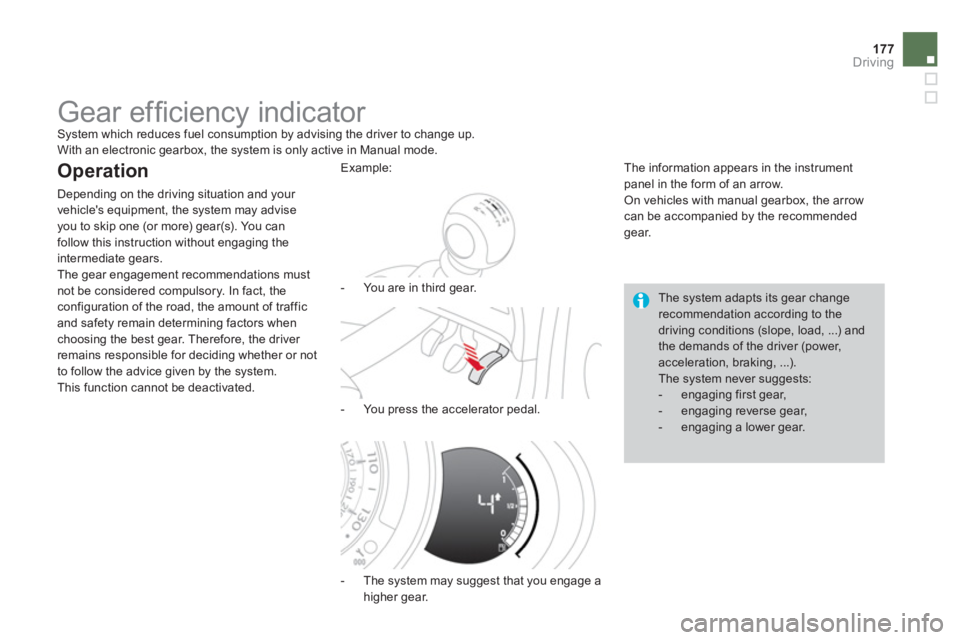
177Driving
Gear effi ciency indicator System which reduces fuel consumption by advising the driver to change up.
With an electronic gearbox, the system is only active in Manual mode.
Operation
Depending on the driving situation and your
vehicle's equipment, the system may advise
you to skip one
(or more) gear(s). You can follow this instruction without engaging the
intermediate gears.
The gear engagement recommendations mustnot be considered compulsory. In fact, the configuration of the road, the amount of traffic
and safety remain determining factors whenchoosing the best gear. Therefore, the driver
remains responsible for deciding whether or not
to follow the advice given by the system.
This function cannot be deactivated.
- The s
ystem may suggest that you engage a
higher gear.
The in
formation appears in the instrument panel in the form of an arrow.
On vehicles with manual gearbox, the arrow can be accompanied by the recommendedgear.
The system adapts its gear change recommendation according to thedriving conditions (slope, load, ...) and the demands of the driver (power,acceleration, braking, ...). The system never suggests:
- engaging first gear,
- engaging reverse gear,
- engaging a lower gear.
Example:
- You are in third
gear.
- You press the accelerator pedal.
Page 180 of 384
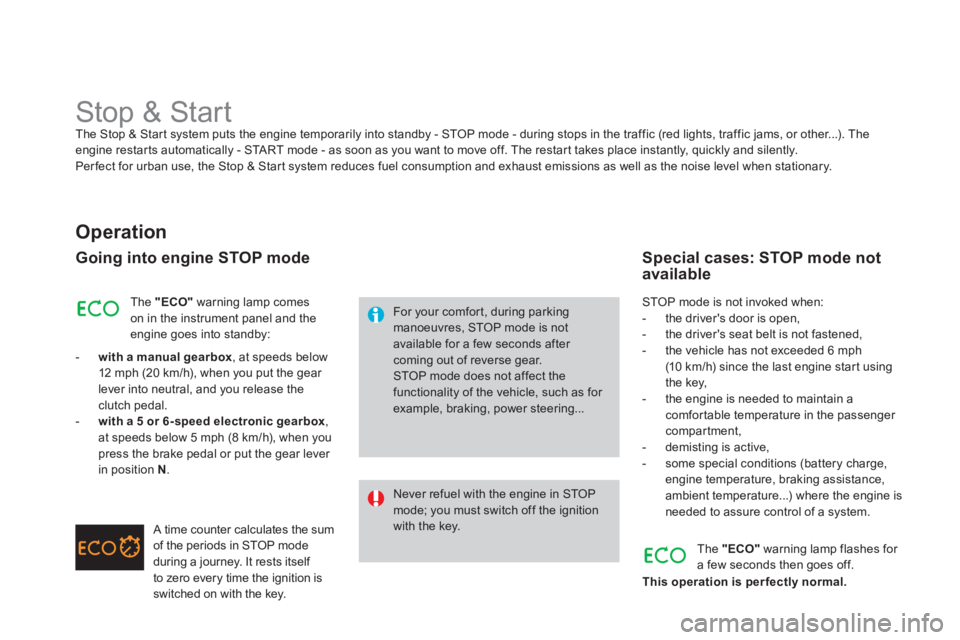
Stop & Start The Stop & Start system puts the engine temporarily into standby - STOP mode - during stops in the traffic (red lights, traffic jams, or other...). The engine restar ts automatically - START mode - as soon as you want to move off. The restar t takes place instantly, quickly and silently.
Per
fect for urban use, the Stop & Start system reduces fuel consumption and exhaust emissions as well as the noise level when stationary.
Operation
Going into engine STOP mode
For your comfor t, during parkingmanoeuvres, STOP mode is not available for a few seconds after coming out of reverse gear.STOP mode does not affect the functionality of the vehicle, such as for example, braking, power steering...
Never refuel with the engine in STOPmode; you must switch off the ignition with the key. Th
e "ECO"warning lamp comes
on in the instrument panel and the engine goes into standby:
- with a manual gearbox
, at speeds below
12 mph (20 km/h), when you put the gear lever into neutral, and you release theclutch pedal. -with a 5 or 6-speed electronic gearbox ,
at speeds below 5 mph (8 km/h), when you press the brake pedal or put the gear lever in position N.
A time counter calculates the sum
of the periods in STOP mode
during a journey. It rests itself
to zero every time the ignition is switched on with the key.
STOP mode is not invoked when:
- the driver's door is open,
- the driver's seat belt is not fastened,
- the vehicle has not exceeded 6 mph(10 km/h) since the last engine star t using
the key,
- the engine is needed to maintain acomfortable temperature in the passenger compartment,
- demisting is active,
- some special conditions (battery charge, engine temperature, braking assistance,ambient temperature...) where the engine isneeded to assure control of a system.
Special cases: STOP mode not available
The "ECO"warning lamp flashes for
a few seconds then goes off.
This operation is per fectly normal.
Page 181 of 384

179Driving
Going into engine START mode
The "ECO"warning lamp goes off and the engine star ts:
-
with a manual gearbox
, when you
depress the clutch pedal,
-
with a 5-speed or 6-speed electronic gearbox:
●
gear lever in position Aor M
, when yourelease the brake pedal,
●
or gear lever in position Nand the brake pedal released, when you move the gear lever to position A
or M,
●
or when you engage reverse gear.
Special cases: START invoked automatically
If the system has been deactivatedin STOP mode, the engine restar ts immediately.
At any time, press the "ECO OFF"
switch todeactivate the system.
This is confirmed by the switch warning lamp coming on accompanied by a message in the screen.
Deactivation
For reasons of safety and for your comfort,START mode is invoked automatically when:
- you open the driver's door,
- you unfasten the driver's seat belt,
- the speed of the vehicle exceeds 7 mph
(11 k m/h) with the electronic gearbox system,
- some special conditions (battery charge,engine temperature, braking assistance,
ambient temperature...) where the engine is
needed for control of a system.
Th
e "ECO"
warning lamp flashes for
a few seconds, then goes off.
This operation is per fectly normal.
With a manual gearbox in STOP mode,if you engage a gear without fully depressing the clutch pedal, a message is displayed asking you to fully depressthe clutch pedal so that the engine can restart.
Page 183 of 384
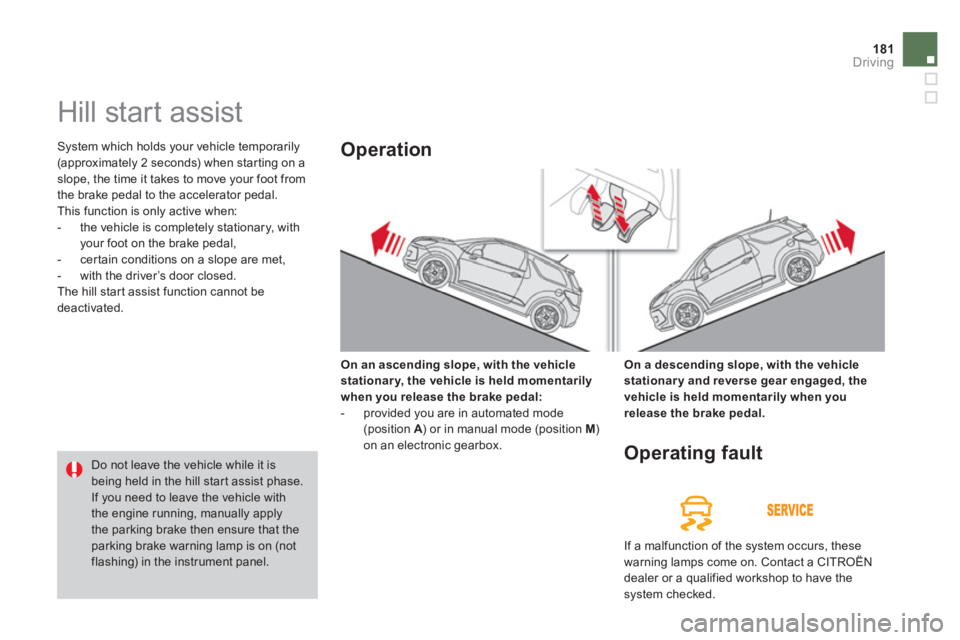
181Driving
Hill start assist
System which holds your vehicle temporarily (approximately 2 seconds) when star ting on a slope, the time it takes to move your foot from
the brake pedal to the accelerator pedal.
This function is onl
y active when:
- the vehicle is completel
y stationary, with your foot on the brake pedal,
- certain conditions on a slope are met,
- with the driver’s door closed.
The hill start assist function cannot bedeactivated.
On an ascending slope, with the vehicle
stationar
y, the vehicle is held momentarilywhen you release the brake pedal:- provided you are in automated mode(position A) or in manual mode (position AM )
on an electronic gearbox.
Do not leave the vehicle while it is being held in the hill star t assist phase.
If you need to leave the vehicle withthe engine running, manually apply the parking brake then ensure that the parking brake warning lamp is on (notflashing) in the instrument panel.
Operation
On a descending slope, with the vehicle
stationary and reverse gear engaged, thevehicle is held momentarily when you
release the brake pedal.
Operating fault
If a malfunction of the system occurs, these
warning lamps come on. Contact a CITROËN
dealer or a qualified workshop to have the
system checked.
Page 186 of 384
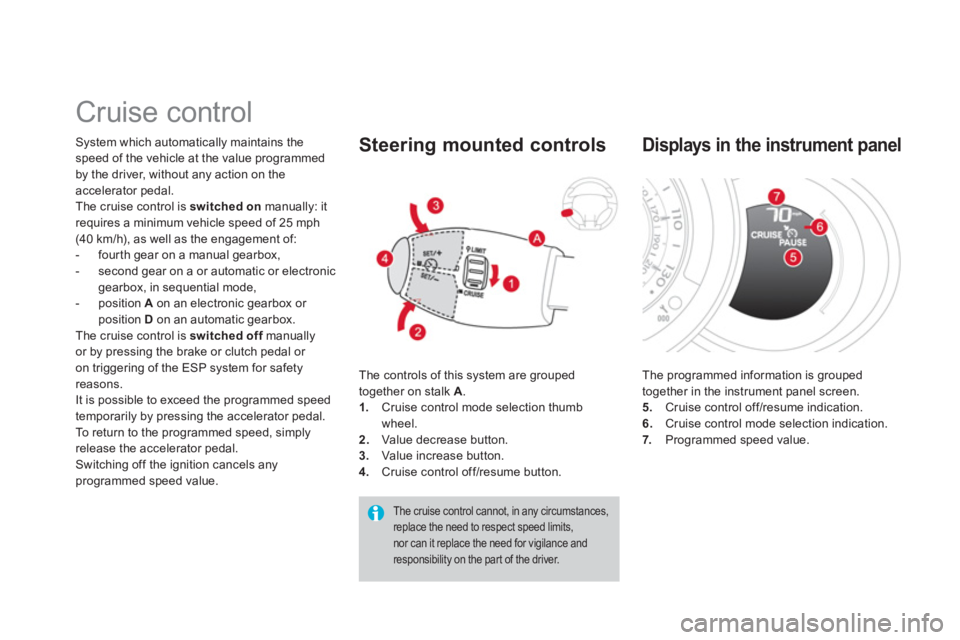
Cruise control
System which automatically maintains the
speed of the vehicle at the value programmed
by the driver, without any action on the accelerator pedal.
The cruise control is switched on
manually: itrequires a minimum vehicle speed of 25 mph
(40 km/h), as well as the engagement of:
- fourth gear on a manual gearbox,
- second gear on a or automatic or electronic
gearbox, in sequential mode,
-
position A
on an electronic gearbox or position D
on an automatic gearbox.
The cruise control is switched offmanuallyfor by pressing the brake or clutch pedal or
on triggering of the ESP system for safety reasons. It is possible to exceed the programmed speed
temporarily by pressing the accelerator pedal.
To return to the programmed speed, simply
release the accelerator pedal.
Switching off the ignition cancels any programmed speed value. The controls o
f this system are grouped
together on stalk A
.
1.Cruise control mode selection thumb
wheel.
2. Value decrease button. 3.
Value increase button. 4.Cruise control off/resume button.
Steering mounted controls
The cruise control cannot, in any circumstances, replace the need to respect speed limits, nor can it replace the need for vigilance and responsibility on the par t of the driver.
The programmed information is grouped
together in the instrument panel screen.
5. Cruise control off/resume indication.
6. Cruise control mode selection indication.
7. Programmed speed value.
Displays in the instrument panel
Page 201 of 384
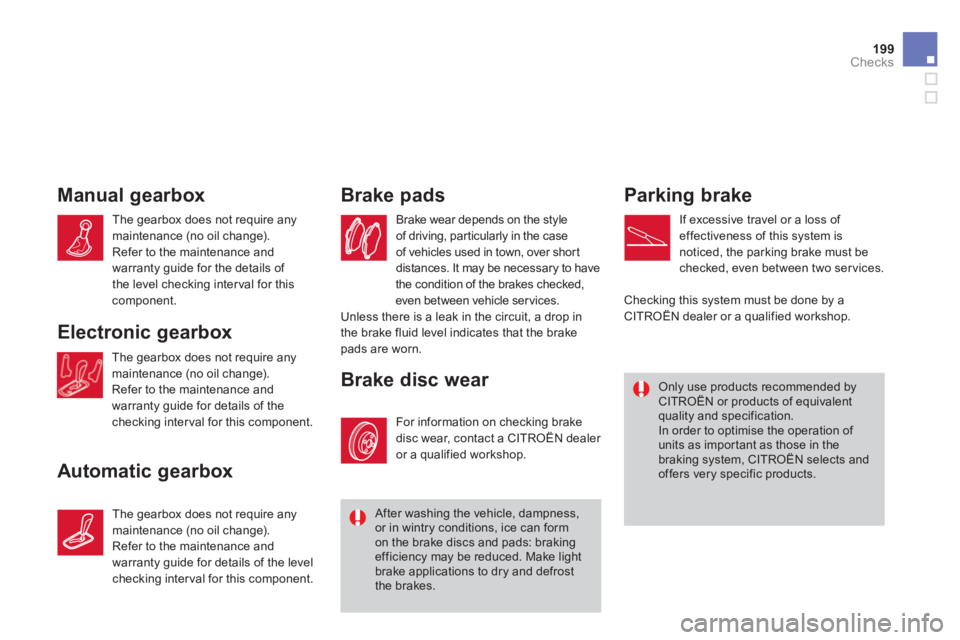
199Checks
Manual gearbox
Automatic
gearboxBrake
pads
Brake wear depends on the style
of driving, par ticularly in the case
of vehicles used in town, over shor tdistances. It may be necessary to have
the condition of the brakes checked, even between vehicle services. The
gearbox does not require any
maintenance (no oil change).
Refer to the maintenance and
warranty guide for the details of
the level checking interval for this component.
Only use products recommended by CITROËN or products of equivalent quality and specification.
In order to optimise the operation of units as important as those in thebraking system, CITROËN selects and offers very specific products.
The gearbox does not require any
maintenance (no oil change).
Refer to the maintenance and
warranty guide for details of the levelchecking interval for this component.
Electronic gearbox
The gearbox does not require anymaintenance (no oil change).
Refer to the maintenance and warranty guide for details of the checking interval for this component.
For information on checking brake
disc wear, contact a CITROËN dealer
or a qualified workshop.
Brake disc wear Parkin
g brake
If excessive travel or a loss of effectiveness of this system is
noticed, the parking brake must be checked, even between two services.
Unless there is a leak in the circuit, a drop in
th
e brake fluid level indicates that the brake pads are worn. Checkin
g this system must be done by aCITROËN dealer or a qualified workshop.
After washing the vehicle, dampness, or in wintry conditions, ice can form on the brake discs and pads: brakingefficiency may be reduced. Make light brake applications to dry and defrost the brakes.
Page 214 of 384
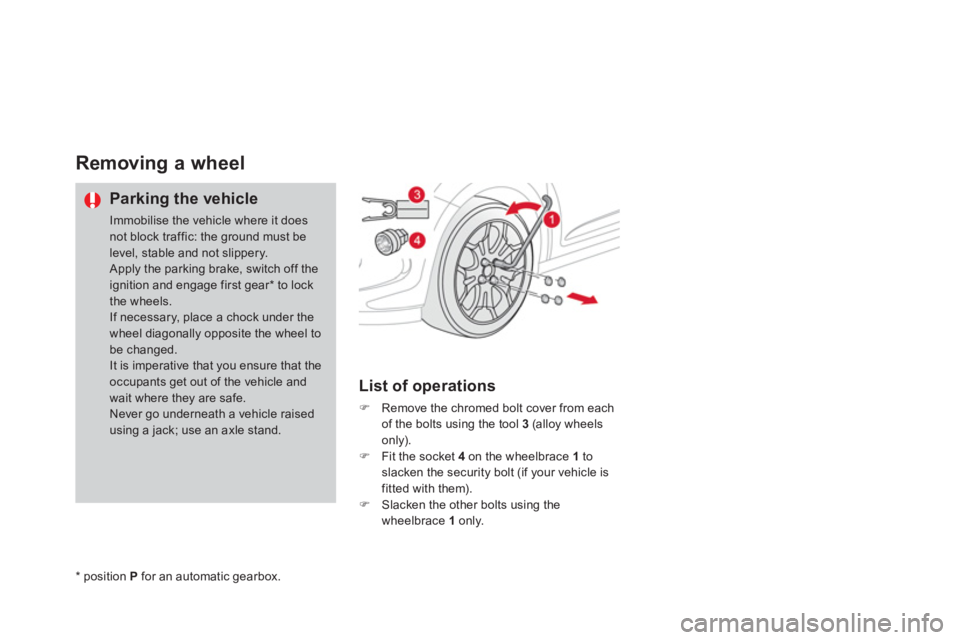
Removing a wheel
Parking the vehicle
Immobilise the vehicle where it does not block traffic: the ground must belevel, stable and not slippery. Apply the parking brake, switch off the ignition and engage first gear * to lock the wheels.
If necessary, place a chock under thewheel diagonally opposite the wheel to be changed. It is imperative that you ensure that the occupants get out of the vehicle andwait where they are safe.
Never go underneath a vehicle raised using a jack; use an axle stand.
List of operations
�)
Remove the chromed bolt cover from each of the bolts using the tool 3 (alloy wheels
only).�)
Fit the socket 4 on the wheelbrace 1to slacken the security bolt (if your vehicle isfitted with them).�)
Slacken the other bolts using the
wheelbrace 1only.
* position
P
for an automatic gearbox.
Page 229 of 384
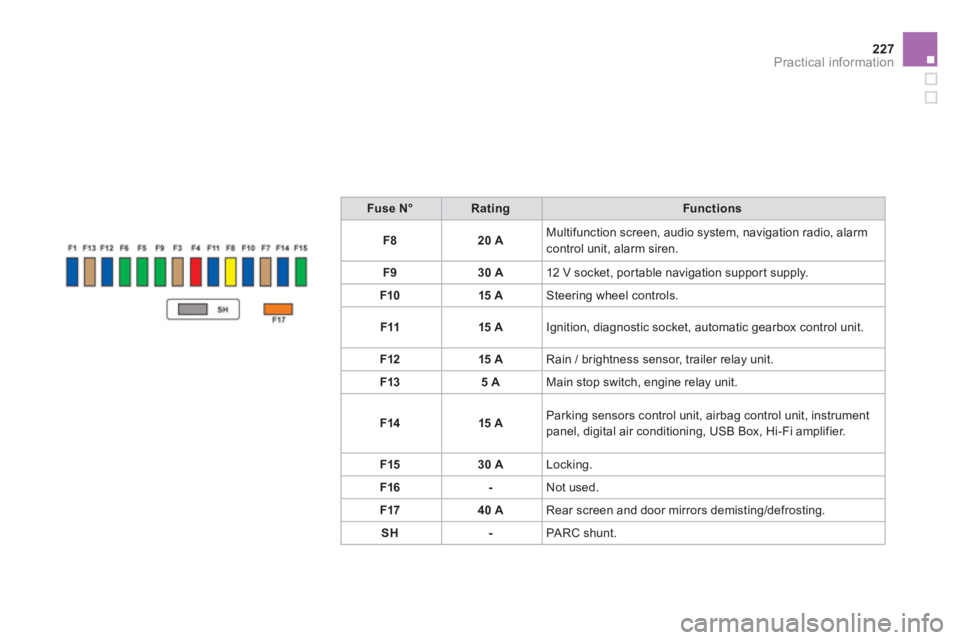
227Practical information
Fuse N°RatingFunctions
F820 AMultifunction screen, audio system, navigation radio, alarmcontrol unit, alarm siren.
F
930 A12 V socket, portable navigation suppor t supply.
F10 15
ASteering wheel controls.
F1
115 AIgnition, diagnostic socket, automatic gearbox control unit.
F1
215 ARain / brightness sensor, trailer relay unit.
F1
35 AMain stop switch, engine relay unit.
F1415 AParking sensors control unit, airbag control unit, instrument panel, digital air conditioning, USB Box, Hi-Fi amplifier.
F15
30 ALocking.
F1
6-Not used.
F1740 ARear screen and door mirrors demisting/defrosting.
S
H-PA RC shunt.
Page 231 of 384
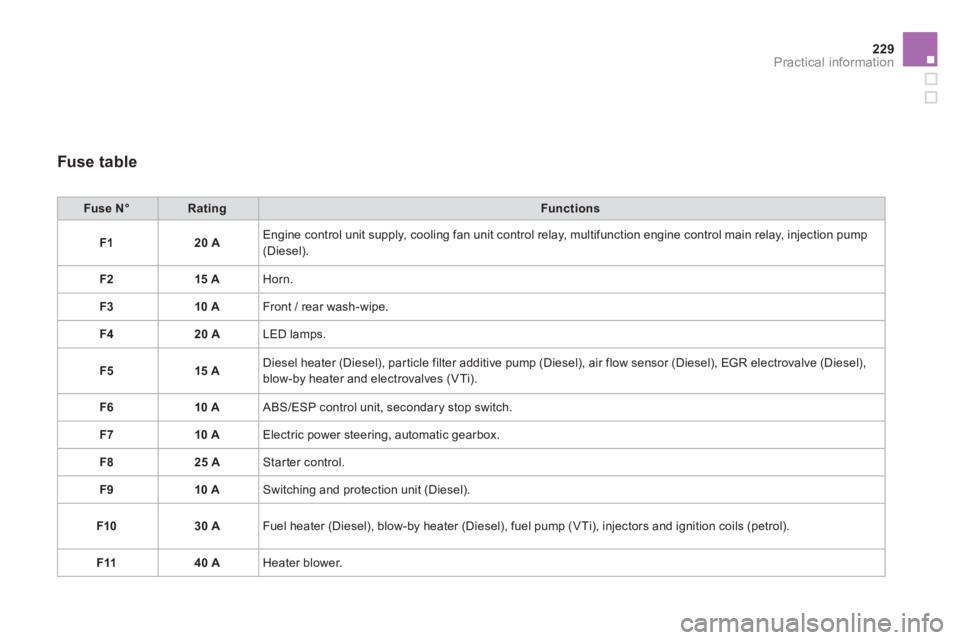
229Practical information
Fuse table
Fuse N°RatingFunctions
F120 A
Engine control unit supply, cooling fan unit control relay, multifunction engine control main relay, injection pump(Diesel).
F
215 A Horn.
F
310 A Front / rear wash-wipe.
F420 A LED lamps.
F5
15 A Diesel heater (Diesel), particle filter additive pump (Diesel), air flow sensor (Diesel), EGR electrovalve (Diesel),
blow-by heater and electrovalves (VTi).
F
610 A ABS/ESP control unit, secondary stop switch.
F
710 A Electric power steering, automatic gearbox.
F8
25 A Starter control.
F
910 A Switching and protection unit (Diesel).
F10 30 A
Fuel heater
(Diesel), blow-by heater (Diesel), fuel pump (VTi), injectors and ignition coils (petrol).
F1140 A Heater blower.
Page 236 of 384

Protect your eyes and face beforehandling the battery. All operations on the battery must be carried out in a well ventilated areaaway from naked flames and sources of sparks, so as to avoid the risk of explosion and fire.Do not try to charge a frozen battery;the battery must first be thawed out toavoid the risk of explosion. If the batteryhas been frozen, before charging haveit checked by a CITROËN dealer or a qualified workshop who will check thatthe internal components have not been damaged and the casing is not cracked,which could cause a leak of toxic andcorrosive acid.
Do not reverse the polarity and useonly a 12 V charger. Do not disconnect the terminals while the engine is running. Do not charge the batteries without disconnecting the terminals first. Wash your hands after wards.
Do not push the vehicle to star t the engine if you have an electronicgearbox or automatic gearbox.
Charging the battery using
a battery charger
Batteries contain harmful substances such as sulphuric acid and lead. They must bedisposed of in accordance with regulationsand must not, in any circumstances, be discarded with household waste. Ta k e used remote control batteries andvehicle batteries to a special collection point.
�)Follow the instructions for use provided by
the manufacturer of the charger.
Do not disconnect the battery to charge it.